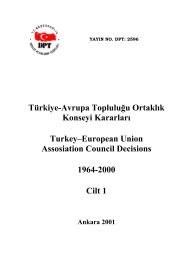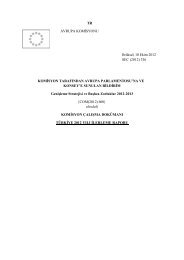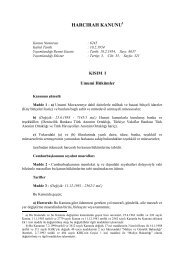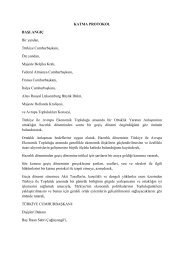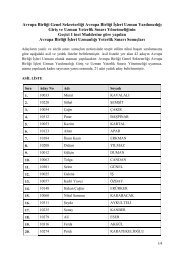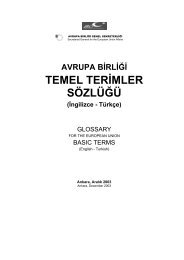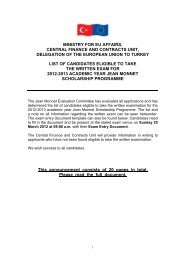2010 ilerleme raporu - Avrupa BirliÄi BakanlıÄı
2010 ilerleme raporu - Avrupa BirliÄi BakanlıÄı
2010 ilerleme raporu - Avrupa BirliÄi BakanlıÄı
You also want an ePaper? Increase the reach of your titles
YUMPU automatically turns print PDFs into web optimized ePapers that Google loves.
accountability, efficiency and transparency of the budgeting process would benefit from a<br />
modernisation of the public audit, while the adoption of the draft Turkish Competition<br />
Authority Law would contribute to less opacity on state aids in public finances. The<br />
unification of all tax administration functions under the Revenue Administration announced<br />
earlier has not been implemented in full. This unification would strengthen the audit capacity<br />
and facilitate greater use of standard risk-based audit techniques, thereby enhancing<br />
transparency and providing significant support for reducing informality. Overall, measures to<br />
increase fiscal transparency were modest.<br />
Over the last few years, Turkey had successfully implemented a strong stabilisation<br />
programme and the resilience of the Turkish economy had benefited from in-depth structural<br />
reforms in many key areas, including banking, restructuring of enterprises and privatisation,<br />
education and energy. Although the financial crisis has hit the Turkish real economy hard, the<br />
earlier regulatory and supervisory reforms have paid off and growth resumed rapidly and<br />
strongly. Turkey’s fiscal and monetary policy mix proved successful during the crisis and<br />
adjustments are being made in order to benefit from the recovery. A new draft law<br />
establishing a fiscal anchor that has potential for considerably improving the fiscal<br />
performance over time, as well as removing the current pro-cyclical bias of fiscal policy, was<br />
submitted to parliament in mid-July, but its discussion was postponed. Making more progress<br />
with fiscal transparency, strengthening the inflation targeting and preserving financial stability<br />
will be important to minimise the risks of a boom-bust scenario. Overall, although the current<br />
policy mix has proved effective in recent months, macroeconomic stability remains<br />
vulnerable and could benefit from a stronger fiscal anchor.<br />
Interplay of market forces<br />
The government has confirmed the independence of the regulatory and surveillance agencies.<br />
But despite the regulatory framework, government authorities still tend to set the prices in<br />
some key areas, including in electricity and gas markets, and to a lesser extent in<br />
telecommunications and transportation, in particular in rail transportation. Liberalisation of<br />
backbone services has advanced significantly and prepared the ground for several successful<br />
privatisations in the energy sector. Indeed, Turkey continued its privatisation efforts in a more<br />
challenging and crisis-prone environment. Total privatisations completed decreased from €4.4<br />
billion (1% of GDP) in 2008 to €1.6 billion (0.4% of GDP) in 2009. A total of 106<br />
transactions were completed in 2009. Ongoing major privatisations include the transfer of<br />
operating rights for 52 small-scale hydropower plants plus the privatisation of four sugar<br />
companies, electricity distribution in 13 regions and three ports. Overall, some progress has<br />
been made on improving the interplay of market forces. Privatisation has advanced, albeit at a<br />
slower pace due to the worsening external environment.<br />
Market entry and exit<br />
In 2009, the economic circumstances had a major impact on market entry and exit. The<br />
number of newly established firms decreased by 10%, while the number of firms which were<br />
closed down increased by 8.5%. Foreign owners still face restrictions in various areas,<br />
including maritime transport, civil aviation, ground-handling, road transport, radio and TV<br />
broadcasting, energy, accountancy and education. Licensing procedures are relatively lengthy.<br />
For example, 25 different procedures are still needed in order to build a warehouse, from<br />
securing licences and permits to completing the necessary notifications and inspections and<br />
obtaining utility connections. Market exit is difficult too, as closing a business still takes 3.3<br />
years on average. Moreover, claimants recover only one fifth of their claims from insolvent<br />
EN 41 EN




